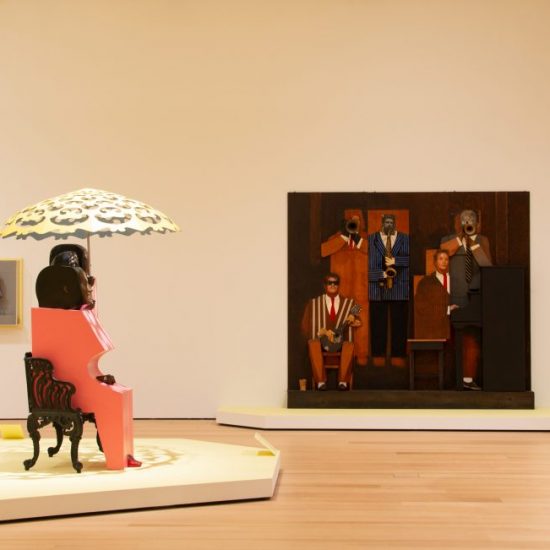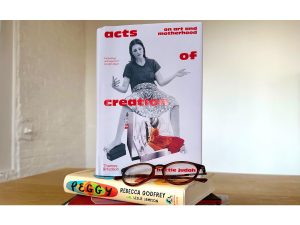“Marisol: A Retrospective” is the most significant retrospective to date dedicated to the art of Marisol (Venezuelan and American, born France, 1930–2016), one of the most prominent yet least well-known artists of her generation, who bequeathed her estate to the Buffalo AKG in 2016. Featuring nearly 250 artworks, including 39 on view for the first time in the tour, “Marisol: A Retrospective” will be installed across the 9,500-square-foot third floor of the new Jeffrey E. Gundlach Building.
Organized by the Buffalo AKG and curated by Cathleen Chaffee, the museum’s Charles Balbach Chief Curator, “Marisol: A Retrospective” first opened at the Montreal Museum of Fine Arts on October 7, 2023, and subsequently traveled to the Toledo Museum of Art. Following the presentation in Buffalo, which will conclude on January 6, 2025, the exhibition’s final stop will be the Dallas Museum of Art, where it will be on view from February 23 through July 6, 2025. The most comprehensive exhibition of Marisol’s work ever assembled, the retrospective reckons with the entirety of the artist’s pioneering, multifaceted, nearly sixty-year career, illuminating the potency and contemporary relevance of her vast practice. Marisol’s satirical and deceptively political sculptures helped define Pop Art in the 1960s and established her as the rising woman artist of her generation. However, in subsequent decades, her work has, until now, remained largely unseen, unstudied, and unappreciated. By examining and contextualizing her work over its long arc, “Marisol: A Retrospective” reveals a full picture of an artist in all her complexity.
The exhibition draws largely on the collection of artworks Marisol kept in her possession and left to the Buffalo AKG upon her death. Spanning her nearly sixty-year career, the bequest includes hundreds of sculptures and studies, including some of her best-known works, hundreds of works on paper, thousands of photographs and slides, and the artist’s papers. Due to this bequest, the Buffalo AKG holds the world’s most significant collection of Marisol’s work. The relationship between the Buffalo AKG and Marisol began in 1962, when, with the purchase of The Generals, 1961–62, from the artist’s solo exhibition that year at the Stable Gallery, the museum became the first institution to acquire her work. The acquisition of Baby Girl, 1963, followed soon thereafter. From 1964 to 1993, Marisol was represented by the New York gallery led by Buffalo native Sidney Janis, who fostered the artist’s career. This history seems to have inspired her decision to leave her estate to the Buffalo AKG. The bequest positions the museum to present a uniquely rich perspective on the art and persona of this groundbreaking, under-researched artist. “Marisol: A Retrospective” marks the culmination of more than six years of research and conservation of the artist’s estate led by Chaffee and the Buffalo AKG team. “On behalf of the Buffalo AKG and our honored role as caretakers of Marisol’s estate, it has been a tremendous privilege to shape a retrospective of her life’s work,” said Chaffee. “This exhibition and its accompanying catalogue are momentous first steps in sharing the true legacy and impact of Marisol’s multi-faceted and radical practice. It is deeply meaningful to present the retrospective here in Buffalo at the museum with which she had such a profound connection.”
Encompassing nearly 250 objects, including archival content and ephemera, the exhibition will unfold over roughly 9,500 square feet, with materials grouped into six thematic sections tracing Marisol’s career as it developed from the 1950s to the early 2000s. The exhibition begins with Marisol’s emergence in the 1950s—her first forays into sculpture and her largely never-before-seen body of works on paper from that period. From the 1960s, the show includes a selection of the Pop sculptures that made Marisol a mid-century celebrity, culminating in her most virtuosic and monumental work of the period, The Party, 1965–66, which thematizes womanhood in 1960s New York society. In a rare reunion since their debut at the Sidney Janis Gallery in 1964, the retrospective includes the Buffalo AKG’s sculpture Baby Girl, 1963, and the companion sculpture Baby Boy, 1962–63 (Collection of Susan G. and Richard M. Rieser, Jr., Palm Beach, Florida)—two of Marisol’s most iconic works from this period that provocatively address Cold War concerns alongside the pressures of femininity and motherhood.
Subsequent sections of the exhibition problematize the conception of the artist as a 1960s siren that defined her for the rest of her life, shedding light on her artistic engagement with issues of ecology, anti-war movements, second-wave feminism, global inequities, and racial and ethnic disenfranchisement. Sculptural works such as Barracuda, 1971 and Needlefish III, 1973—representations of fish that bear a striking resemblance to missiles and other forms of weaponry—reveal Marisol’s engagement with the natural world as well as global political events such as the Vietnam War; while large-scale drawings with confrontational titles such as I Hate You Creep and Your Fetus, 1973, harness second-wave feminist anger. Works such as Boy with Empty Bowl, 1987, created for a landmark traveling exhibition that sought to end world hunger, and Woman with Child and Two Lambs, 1995, recast a longstanding motif of her career, that of the mother and child, within a broader sociopolitical context, demonstrating Marisol’s ongoing engagement with the politics of her time. Areas of Marisol’s practice that have thus far evaded public presentation and appreciation—primarily her collaborative work with dance companies and her public sculpture, important spheres of activity from the 1970s onward—at last receive their proper due. Marisol created sets and costumes for some of the most prominent dance companies of the later twentieth century, including the Louis Falco Dance Company and the Martha Graham Dance Company. Ephemera, photography, and video documentation related to these collaborations will be publicly exhibited for the first time. Marisol’s extensive public sculptures dedicated to subjects as wide-ranging as Hawaii’s Father Damien, 1969, and Manhattan’s American Merchant Mariners’ Memorial, 1988, will be presented in a gallery space for the first time—represented through preparatory sketches, maquettes, research documents, and source photographs of the figures memorialized in her monuments.
Far more than a muse or an icon of a single decade, Marisol created art that addressed and interrogated challenging and urgent issues of the twentieth and now twenty-first centuries in radical ways. Through its presentation of not only the artist’s six decades of work realized across media, but also previously unseen archival material and ephemera, “Marisol: A Retrospective” offers an extraordinary experience of the breadth of her groundbreaking practice, her complex subjectivity, as well as her powerful creative agency.
at Buffalo AKG Art Museum
until January 6, 2024




